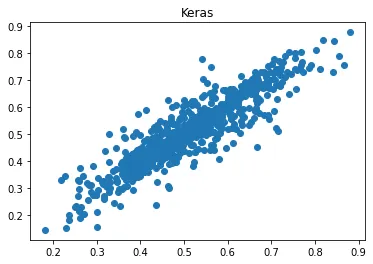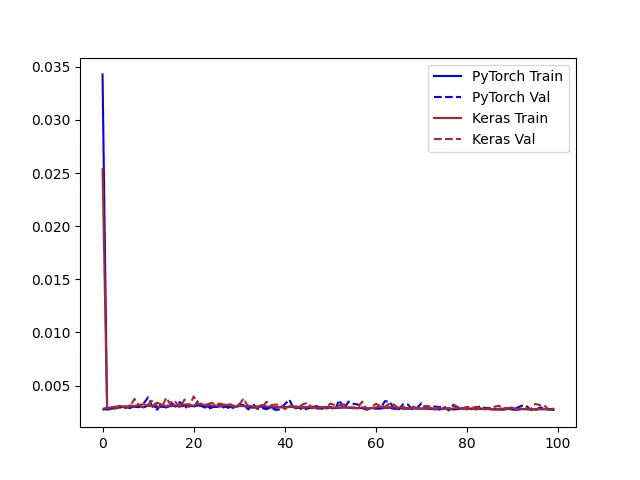简述:
一个使用PyTorch训练的简单(单层隐藏层)前馈模型,用于预测函数y = sin(X1) + sin(X2) + ... sin(X10),其性能明显不如使用Keras构建/训练的相同模型。为什么会这样,并且有什么方法可以缓解性能差异?
在训练回归模型时,我注意到PyTorch与使用Keras构建的相同模型相比性能明显下降。
此现象以前已经被观察和报告过:
以下解释和建议以前也已经提出过:
在使用
autograd.grad计算二阶导数时,将retain_graph=True更改为create_graph=True: 1确保以相同的方式计算验证损失: 1
更长时间地训练PyTorch模型:1
尝试多个随机种子:1
确保在训练PyTorch模型时,在验证步骤中调用
model.eval():1主要问题出在Adam优化器上,而不是初始化:1
以下是我的代码:
0. 导入
import numpy as np
from scipy.stats import pearsonr
from sklearn.preprocessing import MinMaxScaler
from sklearn import metrics
from torch.utils.data import Dataset, DataLoader
import tensorflow as tf
from tensorflow.keras import layers
from tensorflow.keras.regularizers import L2
from tensorflow.keras.models import Model
from tensorflow.keras.optimizers import Adam
1. 生成可再现的数据集
def get_data():
np.random.seed(0)
Xtrain = np.random.normal(0, 1, size=(7000,10))
Xval = np.random.normal(0, 1, size=(700,10))
ytrain = np.sum(np.sin(Xtrain), axis=-1)
yval = np.sum(np.sin(Xval), axis=-1)
scaler = MinMaxScaler()
ytrain = scaler.fit_transform(ytrain.reshape(-1,1)).reshape(-1)
yval = scaler.transform(yval.reshape(-1,1)).reshape(-1)
return Xtrain, Xval, ytrain, yval
class XYData(Dataset):
def __init__(self, X, y):
super(XYData, self).__init__()
self.X = torch.tensor(X, dtype=torch.float32)
self.y = torch.tensor(y, dtype=torch.float32)
self.len = len(y)
def __getitem__(self, index):
return (self.X[index], self.y[index])
def __len__(self):
return self.len
# Data, dataset, and dataloader
Xtrain, Xval, ytrain, yval = get_data()
traindata = XYData(Xtrain, ytrain)
valdata = XYData(Xval, yval)
trainloader = DataLoader(dataset=traindata, shuffle=True, batch_size=32, drop_last=False)
valloader = DataLoader(dataset=valdata, shuffle=True, batch_size=32, drop_last=False)
2. 使用相同的超参数和初始化方法构建Keras和PyTorch模型
class TorchLinearModel(nn.Module):
def __init__(self, input_dim=10, random_seed=0):
super(TorchLinearModel, self).__init__()
_ = torch.manual_seed(random_seed)
self.hidden_layer = nn.Linear(input_dim,100)
self.initialize_layer(self.hidden_layer)
self.output_layer = nn.Linear(100, 1)
self.initialize_layer(self.output_layer)
def initialize_layer(self, layer):
_ = torch.nn.init.xavier_normal_(layer.weight)
#_ = torch.nn.init.xavier_uniform_(layer.weight)
_ = torch.nn.init.constant(layer.bias,0)
def forward(self, x):
x = self.hidden_layer(x)
x = self.output_layer(x)
return x
def mean_squared_error(ytrue, ypred):
return torch.mean(((ytrue - ypred) ** 2))
def build_torch_model():
torch_model = TorchLinearModel()
optimizer = optim.Adam(torch_model.parameters(),
betas=(0.9,0.9999),
eps=1e-7,
lr=1e-3,
weight_decay=0)
return torch_model, optimizer
def build_keras_model():
x = layers.Input(shape=10)
z = layers.Dense(units=100, activation=None, use_bias=True, kernel_regularizer=None,
bias_regularizer=None)(x)
y = layers.Dense(units=1, activation=None, use_bias=True, kernel_regularizer=None,
bias_regularizer=None)(z)
keras_model = Model(x, y, name='linear')
optimizer = Adam(learning_rate=1e-3, beta_1=0.9, beta_2=0.9999, epsilon=1e-7,
amsgrad=False)
keras_model.compile(optimizer=optimizer, loss='mean_squared_error')
return keras_model
# Instantiate models
torch_model, optimizer = build_torch_model()
keras_model = build_keras_model()
Great! How may I assist you today?
torch_trainlosses, torch_vallosses = [], []
for epoch in range(100):
# Training
losses = []
_ = torch_model.train()
for i, (x,y) in enumerate(trainloader):
optimizer.zero_grad()
ypred = torch_model(x)
loss = mean_squared_error(y, ypred)
_ = loss.backward()
_ = optimizer.step()
losses.append(loss.item())
torch_trainlosses.append(np.mean(losses))
# Validation
losses = []
_ = torch_model.eval()
with torch.no_grad():
for i, (x, y) in enumerate(valloader):
ypred = torch_model(x)
loss = mean_squared_error(y, ypred)
losses.append(loss.item())
torch_vallosses.append(np.mean(losses))
print(f"epoch={epoch+1}, train_loss={torch_trainlosses[-1]:.4f}, val_loss={torch_vallosses[-1]:.4f}")
4. 训练 Keras 模型 100 个 epochs:
history = keras_model.fit(Xtrain, ytrain, sample_weight=None, batch_size=32, epochs=100,
validation_data=(Xval, yval))
5. 训练历史中的损失
plt.plot(torch_trainlosses, color='blue', label='PyTorch Train')
plt.plot(torch_vallosses, color='blue', linestyle='--', label='PyTorch Val')
plt.plot(history.history['loss'], color='brown', label='Keras Train')
plt.plot(history.history['val_loss'], color='brown', linestyle='--', label='Keras Val')
plt.legend()
Keras在训练中记录了更低的误差。由于这可能是由于Keras计算损失的方式不同,我使用sklearn.metrics.mean_squared_error计算了验证集上的预测误差。
6. 训练后的验证误差
ypred_keras = keras_model.predict(Xval).reshape(-1)
ypred_torch = torch_model(torch.tensor(Xval, dtype=torch.float32))
ypred_torch = ypred_torch.detach().numpy().reshape(-1)
mse_keras = metrics.mean_squared_error(yval, ypred_keras)
mse_torch = metrics.mean_squared_error(yval, ypred_torch)
print('Percent error difference:', (mse_torch / mse_keras - 1) * 100)
r_keras = pearsonr(yval, ypred_keras)[0]
r_pytorch = pearsonr(yval, ypred_torch)[0]
print("r_keras:", r_keras)
print("r_pytorch:", r_pytorch)
plt.scatter(ypred_keras, yval); plt.title('Keras'); plt.show(); plt.close()
plt.scatter(ypred_torch, yval); plt.title('Pytorch'); plt.show(); plt.close()
Percent error difference: 479.1312469426776
r_keras: 0.9115184443702814
r_pytorch: 0.21728812737220082
Keras的预测值与实际值的相关性为0.912,而Pytorch的相关性仅为0.217,误差高出479%!
7.其他尝试 我还尝试过:
- 降低Pytorch的学习率(lr = 1e-4),R从0.217增加到0.576,但仍远不如Keras(r = 0.912)。
- 增加Pytorch的学习率(lr = 1e-2),R更糟糕,只有0.095
- 使用不同的随机种子进行多次训练。总体表现大致相同。
- 训练时间超过100个epoch。没有观察到改善!
- 在权重初始化时使用
torch.nn.init.xavier_uniform_而不是torch.nn.init.xavier_normal_。R 从0.217提高到0.639,但仍不如Keras(0.912)。
有什么方法可以确保PyTorch模型收敛到与Keras模型相当的合理误差?




pytorch的MSELoss时会发出警告:UserWarning: 使用目标大小(torch.Size([32, 1]))与输入大小(torch.Size([32]))不同。这可能会由于广播导致结果不正确。一些运行提供的[mre]所需的导入缺失(但很明显)。 - Michael Szczesny